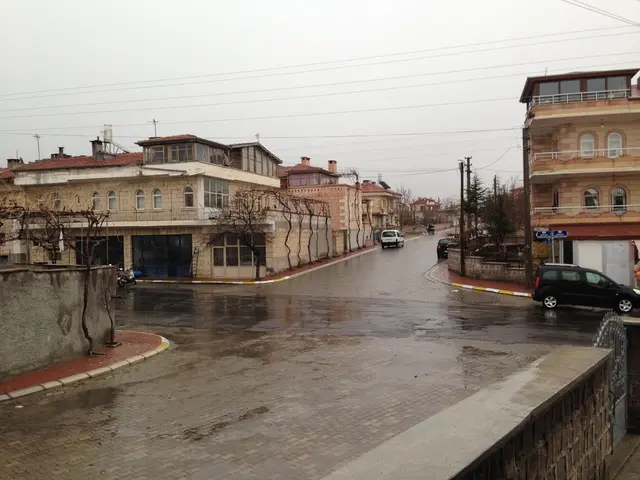U.S.-Mexico dispute over Rio Grande water allocation puts Texas farmers in a dry predicament
In the Heart of Texas' Oldest Farms: The Border Battle Over Rio Grande Water
Positioned in Presidio, Texas, the Rio Grande takes its vital refreshments from Mexico's Rio Conchos, forming a vital water source known as La Junta de los Rios. This area, where the two rivers intertwine, is believed to host the state's oldest continually cultivated farmland.
"For millennia, this land has been providing sustenance, even before Jesus was born" shared Chris Bell, a newcomer to Presidio's farming community. "This whole valley has been a treasure trove, keeping everyone alive."
The fertile soil, combined with the river's accessibility, attracted Bell to this region. His dream is to cultivate alfalfa and turfgrass, revitalizing the decaying agricultural sector that once thrived in Far West Texas.
However, Bell faces formidable challenges. The persistent drought, ever-increasing populations, and aging infrastructure on both sides of the border have complicated Mexico's responsibility to honor a nearly 80-year-old agreement. This treaty compels Mexico to send enormous amounts of water to the U.S. every five years.
"Water shortage has been a headache for everyone," said Bell. "There's not much rain, and a lot of things have changed."
Historically, Mexico has fallen behind on delivering the required water, leading to losses of hundreds of millions of dollars for Texas farms over the last decade, according to one estimate.
Recently, the U.S. administration has applied political pressure, threatening tariffs and even denying water requests to force Mexico's compliance.During Trump's tenure, the U.S. denied Mexico water for the first time in 81 years[1].
However, experts like Rosario Sanchez, a senior research scientist at Texas Water Resources Institute at Texas A&M University, argue that threats and pressure will not resolve the fundamental issue at hand: water scarcity.
"Realistically, we're running on empty," said Sanchez. "Political pressure or tariffs won't bring more water into existence."
Mexico's failings are rooted in low water levels. As a result, the players involved see it as a united problem, rather than a border squabble, with a collective interest in increasing sustainable water resources[4].
As time ticks away — with only six months remaining in the five-year agreement deadline — Mexico has only managed to deliver about 30 percent of the water it owes[3].
Mexican President Claudia Sheinbaum announced immediate water deliveries in April, fulfilling the commitment to the treaty without yielding to external pressure[3]. Yet, these deliveries may not be enough to meet Mexico's full water obligations[3].
Valentin Sanchez, a fellow Presidio farmer, sees the recent agreement as merely a temporary solution. He estimates the relief will last for one to two more months[3]. Once the water runs out, Valentin Sanchez foresees another crisis looming, with potentially devastating consequences for the border and beyond.
"This isn't just a border issue; it affects everyone," said Valentin Sanchez.
The U.S. and Mexico will convene in the summer, just months before the treaty's October deadline, to examine and address water levels and finalize their strategy for the subsequent five-year cycle[3].
Copyright 2025 NPR
[1] Guardian: "Trump threatens to punish Mexico over water dispute," June 6, 2020.[2] CFR: "U.S.-Mexico Water Stress: Changing the Terms of the Treaty," September 12, 2019.[3] Reuters: "Mexico to Deliver Water as U.S. Threatens to Limit Supply," April 18, 2021.[4] National Geographic: "How Climate Change Threatens the World's Agriculture," November 1, 2019.[5]Texas Water Development Board: "1944 U.S.-Mexico Water Treaty Timeline" (accessed June 6, 2021).
- The persistent drought, ever-increasing populations, and aging infrastructure on both sides of the border have exacerbated water shortages, leading to substantial losses for Texas farms and risking further agricultural decline in Far West Texas.
- Experts like Rosario Sanchez argue that political pressure and tariffs will not resolve the fundamental issue of water scarcity, and that increased attention should be given to sustainable water resource development to combat climate change and promote long-term water conservation practices.
- Mexico's failure to deliver the required water has resulted in financial losses of hundreds of millions of dollars for Texas farms over the last decade, calling for comprehensive policy and legislation to address this global environmental issue and ensure the implementation of fair and equitable water management strategies.
- More effective collaboration between the U.S. and Mexico is essential to tackle the challenges associated with climate change, water scarcity, and environmental degradation, as these issues transcend borders and territories and demand a coordinated, cross-disciplinary approach involving political leaders, scientists, and environmental experts alike.







